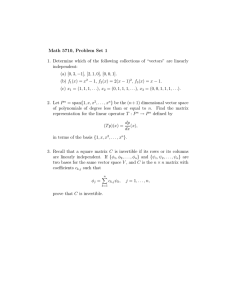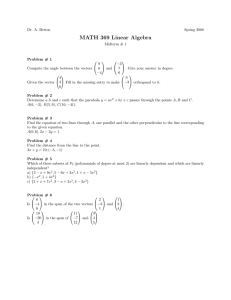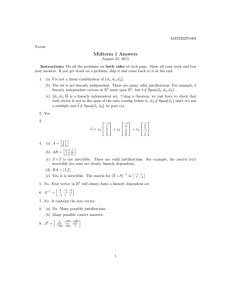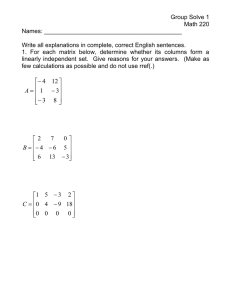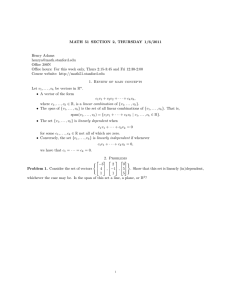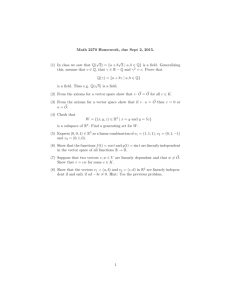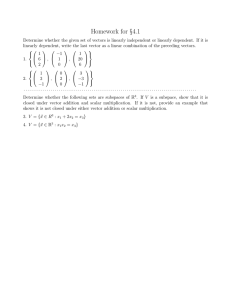solutions
advertisement
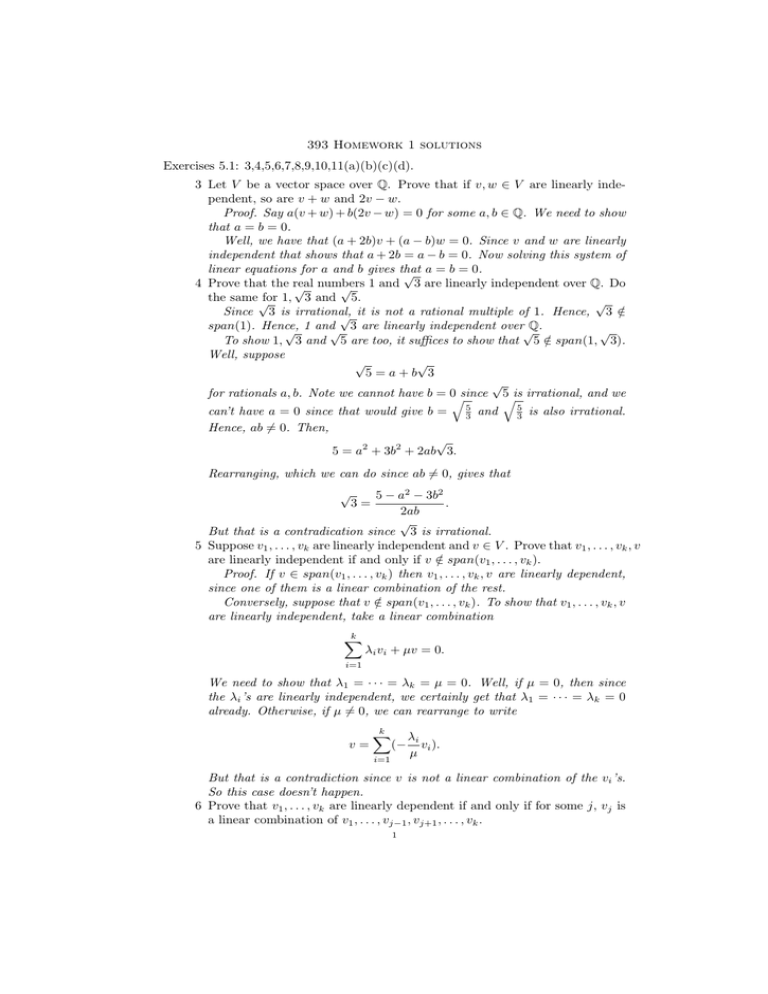
393 Homework 1 solutions Exercises 5.1: 3,4,5,6,7,8,9,10,11(a)(b)(c)(d). 3 Let V be a vector space over Q. Prove that if v, w ∈ V are linearly independent, so are v + w and 2v − w. Proof. Say a(v + w) + b(2v − w) = 0 for some a, b ∈ Q. We need to show that a = b = 0. Well, we have that (a + 2b)v + (a − b)w = 0. Since v and w are linearly independent that shows that a + 2b = a − b = 0. Now solving this system of linear equations for a and b gives that √ a = b = 0. 4 Prove that the real numbers 1 and 3 are linearly independent over Q. Do √ √ the same√ for 1, 3 and 5. √ Since 3 is irrational, / √ it is not a rational multiple of 1. Hence, 3 ∈ span(1). Hence, 1 and 3 are linearly independent over Q. √ √ √ √ To show 1, 3 and 5 are too, it suffices to show that 5 ∈ / span(1, 3). Well, suppose √ √ 5=a+b 3 √ for rationals a, b. Note we cannot have b = 0qsince 5qis irrational, and we 5 can’t have a = 0 since that would give b = 53 and 3 is also irrational. Hence, ab 6= 0. Then, √ 5 = a2 + 3b2 + 2ab 3. Rearranging, which we can do since ab 6= 0, gives that √ 5 − a2 − 3b2 . 2ab √ But that is a contradication since 3 is irrational. 5 Suppose v1 , . . . , vk are linearly independent and v ∈ V . Prove that v1 , . . . , vk , v are linearly independent if and only if v ∈ / span(v1 , . . . , vk ). Proof. If v ∈ span(v1 , . . . , vk ) then v1 , . . . , vk , v are linearly dependent, since one of them is a linear combination of the rest. Conversely, suppose that v ∈ / span(v1 , . . . , vk ). To show that v1 , . . . , vk , v are linearly independent, take a linear combination 3= k X λi vi + µv = 0. i=1 We need to show that λ1 = · · · = λk = µ = 0. Well, if µ = 0, then since the λi ’s are linearly independent, we certainly get that λ1 = · · · = λk = 0 already. Otherwise, if µ 6= 0, we can rearrange to write v= k X (− i=1 λi vi ). µ But that is a contradiction since v is not a linear combination of the vi ’s. So this case doesn’t happen. 6 Prove that v1 , . . . , vk are linearly dependent if and only if for some j, vj is a linear combination of v1 , . . . , vj−1 , vj+1 , . . . , vk . 1 2 Proof. We need to be careful with this one with what we are taking to be the definition of linear independent: remember v1 , . . . , vk are linearly Pk independent if i=1 λi vi = 0 implies λ1 = · · · = λk = 0. Hence, if v1 , . . . , vk are linearly dependent, we have that k X λi vi = 0 i=1 for scalars λ1 , . . . , λk where at least one λj 6= 0. But then we can rearrange it as λj−1 λj+1 λk λ1 vj−1 − vj+1 − · · · − vk vj = − v1 − · · · − λj λj λj λj and we have rewritten vj as a linear combination of the rest for some j. Conversely, if vj is a linear combination of the rest, say vj = λ1 v1 + · · · + λj−1 vj−1 + λj+1 vj+1 + · · · + λk vk , then bringing everything over to the same side gives that λ1 v1 + · · · + λj−1 vj−1 − vj + λj+1 vj+1 + · · · + λk vk = 0 But this is a linear combination equal to zero with not all the coefficients zero (because the vj coefficient is −1). Hence they are linearly dependent. 7 Suppose v ∈ span(v1 , . . . , vk ). Prove that span(v1 , . . . , vk , v) = span(v1 , . . . , vk ). Proof. Obviously, span(v1 , . . . , vk ) ⊆ span(v1 , . . . , vk , v). Conversely, take any x ∈ span(v1 , . . . , vk , v). We need to show that x ∈ span(v1 , . . . , vk ) already. Write k X x= λi vi + µv. i=1 Also write v= k X µi vi . i=1 Then, we get that x= k X (λi + µµi )vi . i=1 Hence x ∈ span(v1 , . . . , vk ) as required. 8 Prove that v1 , . . . , vk are a basis for V if and only if every vector of V can be written uniquely as a linear combination of v1 , . . . , vk . Proof. Suppose v1 , . . . , vk is a basis for V . Then, any vector of V is a linear combination of them since they span. For uniqueness, suppose we have written a vector as a linear combination of them in two different ways: x= k X λi vi = i=1 k X µi vi . i=1 We need to show that λi = µi for each i. Well, 0=x−x= k X i=1 λi vi − k X i=1 µi vi = k X i=1 (λi − µi )vi . 3 Since the vi are linearly independent we get that all the coefficients λi − µi are zero. QED. 9 Let v1 , . . . , vk be linearly independent vectors in a finite dimensional vector space. Show that there are vectors vk+1 , . . . , vn such that v1 , . . . , vk , vk+1 , . . . , vn 10 11(a) 11(b) 11(c) 11(d) form a basis for V . Proof. If v1 , . . . , vk already span V its a basis and we’re done. Else, we can find a vector vk+1 ∈ V with vk+1 ∈ / span(v1 , . . . , vk ). By 5, v1 , . . . , vk , vk+1 are linearly independent. If v1 , . . . , vk+1 span V its a basis and we’re done. Else we can find a vector vk+2 ∈ V with vk+2 ∈ / span(v1 , . . . , vk+1 ). By 5, v1 , . . . , vk+2 are linearly independent. Keep going. The process stops, proving the theorem, in finitely many steps, since in a vector space of dimension n and set of > n vectors is not linearly independent. Let V be n dimensional over F . (a) Prove that if v1 , . . . , vn ∈ V are linearly independent then they span. (b) Prove that if v1 , . . . , vn ∈ V span then they are linearly independent. Proof. (a) If they do not span, we can pick v ∈ V with v ∈ / span(v1 , . . . , vn ). Then by 5, v1 , . . . , vn , v are again linearly independent. But in an n dimensional vector space, n + 1 vectors can never be independent! (b) If they are linearly dependent, by 6 some vj can be expressed as a linear combination of the rest. Hence by 7, span(v1 , . . . , vn ) = span(v1 , . . . , v̂j , . . . , vn ). So we’ve got a spanning set with just n − 1 vectors in them. But in an n dimensional vector √ space, n − 1 vectors can√never span! Give a basis for Q[ √2] over Q. Answer: 1, √ 2 Give a basis for Q[i 3] over Q. Answer: 1, i √ √3 √ Give a basis for Q[√3, i] over Q. √ Answer: 1, 3, i, i 3 (its √ 4 dimensional) √ Give a basis for Q[ 3, i] over Q[i 3]. Answer: Notice Q[ 3, i] = Q[i 3][i]. Hence a basis is 1, i and it is 2 dimensional.
